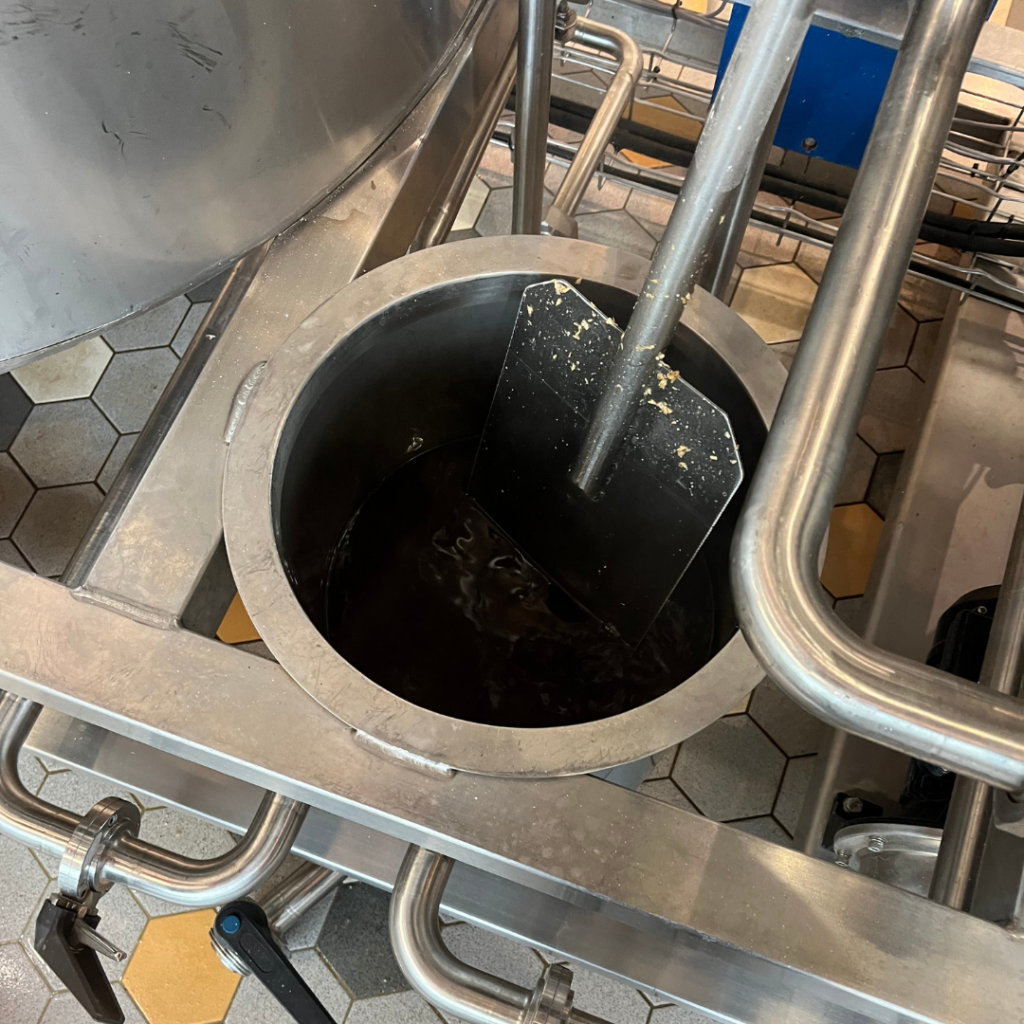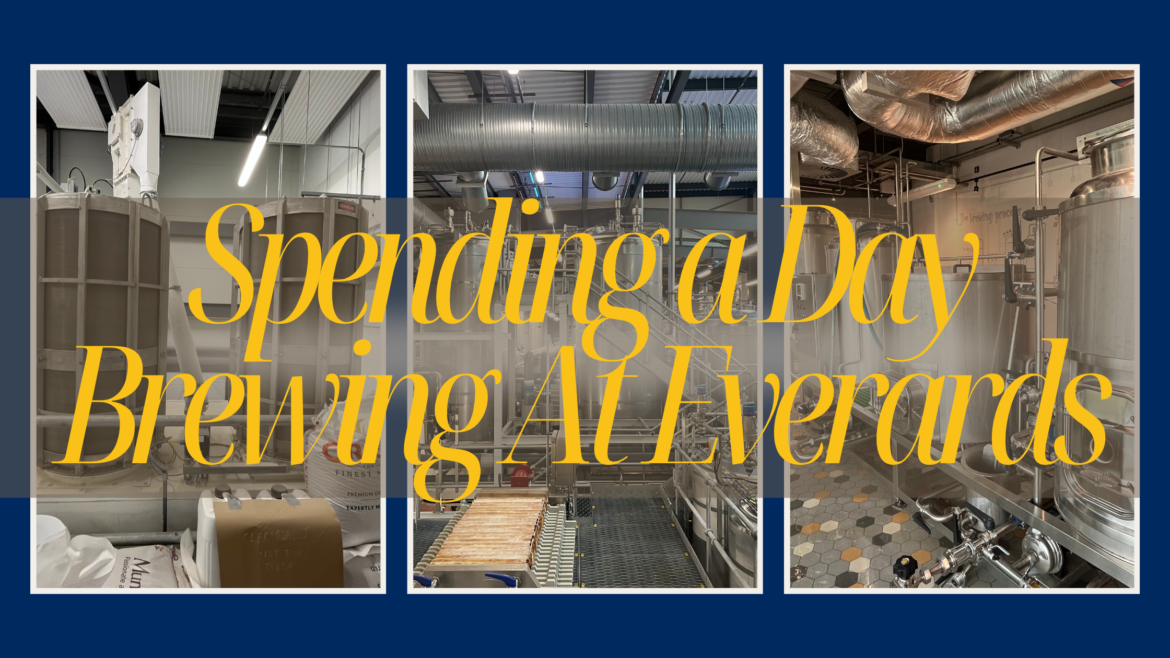Our Beer Connoisseur, Luke Slater has embarked on a new adventure, stepping into the heart of Everards brewery for a unique challenge: crafting an experimental beer! This wasn’t just any beer – it was an opportunity to explore new flavours and create something special that will soon be available for beer enthusiasts to enjoy.
And where better to take on this thrilling task than at Everards Brewery, a cornerstone of Leicestershire’s rich brewing heritage. Read on to hear about the full adventure!
Arriving at Everards Brewery

The smell of malted barley travelling through the air outside the enormous complex of Everards hits you as soon as you step out of the car. There were many spectacular sights coming Luke’s way, and he knew that it was going to be a good day.
Everards Brewery has changed massively over the years after transferring from their old site across the way to the new location. This has meant that they’ve had the opportunity to expand, not just the brewery, but also adding a bar to sample their products and a shop stocked full of Everards goodies makes this a fab place to visit.
As this is on a new estate, it should be noted that the Sat Nav might go wrong, so make sure you look out for the signs to Everards Brewery!
Meeting The Brewing Team at Everards
For the duration of the day, Luke was working with Isaac Moore who started at Everards as an apprentice and has worked his way up to become a full time brewer. He’s very knowledgeable and shares the same passion for beer that Luke has. They spent time exploring their favourite beers, before discussing their plan for brewing the Peachy Pale.
Luke also had the opportunity of meeting with Jon Elks, the Head Brewer at Everards.
*The Pilot brewing unit was the facility that Isaac and Luke used to brew the Peachy Pale.
Luke shared: “He is a man of brewing talent and was a great coach for brewing beer, as he provided some excellent tips on how to make the perfect brew within their Pilot brewing unit* and I can’t thank him enough for sharing his words of wisdom!”
The Pilot Brewing Room at Everards

The Pilot Brewing Room is predominantly used to develop new beers that Everards sells to the public on a trial basis. The main reason for using this Brewing Room is to try various combinations of different aromas that can be balanced together to make a perfect pint, a very important step within the UK’s brewing industry.
The room is split into specific sections and each piece of equipment responds to certain parts of the Brewing Process:
- The Hot Liquor Tank holds boiling water to use throughout the malting process.
- The Mash Tun is where you mix the malt and the hot water to extract the natural sugar from the grist (ground up grains, e.g. barley).
- The Boil Kettle is where a variety of hops are added to the wort (liquid from the mash tun) and this determines what style of beer this will produce, e,g, IPA (India Pale Ale). It wouldn’t be a brewery without a kettle!
- The Fermenting Vessel which is located as far as possible from the Boil Kettle (to help the wort cool down), is the final process of any beer before it’s racked into casks. Fermentation time dictates the strength of the beer.
Brewing Peachy Pale in the Pilot Brewing Room



Luke and Isaac’s first task before starting the brewing process is to make sure that all the equipment being used is spotlessly clean and sanitised. This is a critical step before you can start brewing beer. They both agreed that everything was up to the required standard of cleanliness so it was now time to start the exciting mission, mashing in the malt.
There were four gigantic bags consisting of a mixture of different malts; Maris Otter Pale Malt and Torrified Wheat were the two main malts used to make the Peachy Pale.
At this stage, Luke knew the next part of the brewing process was going to be a two man job, as there are multiple steps that need to be done simultaneously. So whilst Isaac was adding the malt into the mash tun, Luke was stirring the ingredients into a porridge-like consistency and this was certainly hard work! It’s important to match the stirring of the malt with the amount of hot liquor water, as it fills up the mash tun, so attention to detail is required.
After all the malt was mashed, there was an hour’s gap and this time was used to collect all the hops which were needed for boiling. This gave Luke the opportunity to check out another beer which was resting in a different fermenting vessel, which was a dark imperial stout and Isaac mentioned that the aim of this brew was to reach an alcohol content of 6.5% ABV, certainly not a session beer.
Once the hour was up, the next part was to start a process called running off. This is a complex task which requires key timing:
- If you run off the beer too quickly it will cause “unfortunate consequences” which would mess up the whole brewing process.

The wort is transferred from the mash tun, into a container called a “Underback”, which transfers the content into the boiler tank. During this process Luke had to dash between one side of the room and the other, to make sure the heat pump for the boiler was constantly turned on. This job required precision as it’s not a job that you can take your eye off the ball.
After the runoff was completed, it was time to start the boiling process. Once the boiler kettle reached 100°C, the first hop was added to the liquor. Peachy Pale is a tropical style beer, therefore only a small amount of bitter hops were added. The hops that Luke and Isaac were using were pellets. This type of hop is the same as whole hops except it’s in a form of a pellet. A whole help provides more natural characteristics but they’re not as concentrated so you have to use more.
Furthermore, the recipe of Peachy Ale requires dry hops, these hops are added during the Fermentation process. The reason for dry hopping is because it imparts the aroma, the beer will still have certain amounts of aroma from the hops that are added in the boiler, but the dry hop helps to double down on the hop character when in the fermenting vessel.
Whilst the beer was bubbling away nicely in the kettle, Luke and Isaac started to get the yeast ready. Yeast needs to be added to the wort in the fermenting vessel, as it is the yeast fermenting with the sugars in the wort which produces the alcohol.
Once the yeast was ready, it was time to add in the next hop which was amarillo into the boiler tank, this hop provides fruity fragrant aromas which were required for the Peachy Pale.
Compared to the bitter hop, there was a larger amount of amarillo required in the recipe, and when Luke was placing the hops into the tank he could easily visualise how amazing the beer would smell.
After around half an hour, Luke and Isaac came to an agreement, after checking the necessary temperatures, the wort was ready to be transported into the Fermenting Vessel. This was the final step of the brewing process before racking, where the beer has to sit inside a massive container for over a week. Here the beer ferments to reach the optimal alcohol content.
This was a fun step for Luke, as the wort became “alive” and transformed into a foamy beer. Luke imagined it as one giant pint of beer – he’s looking forward to properly tasting this creation!
A Quick Tour of Everards Before Leaving

Similar to the Pilot Brewery, the main brewery was separated into different sections but on a much larger scale. There were three brewing vessels, one of these being a mash tun. Luke was completely in his element, as there was so much to see and take in!
Two of these vessels were a lauter tun and a kettle, it was noted that unlike the pilot brewery the mashing and running off is done in two separate vessels.

Unlike microbreweries, Everards has its own malt grain store and “Beer Lab” where the organoleptic elements (the sensory properties of a product involving taste, colour, odour and mouthfeel) of the beer are checked over multiple times before it is allowed to be sold to the public.
Leaving the Brewery and Luke’s Final Thoughts!
Luke had an outstanding time at Everards, it was a fantastic opportunity where he got the chance to meet one of Leicester’s greatest head-brewers and of course work alongside Isaac sharing their passion for the UK’s Brewing Industry.
Luke had a unique experience brewing this Peachy Ale at Everards and is looking forward to sampling it. Here’s to one of the many experiences that our Beer Connoisseur has taken part in and he is looking forward to the next brewing adventure!





